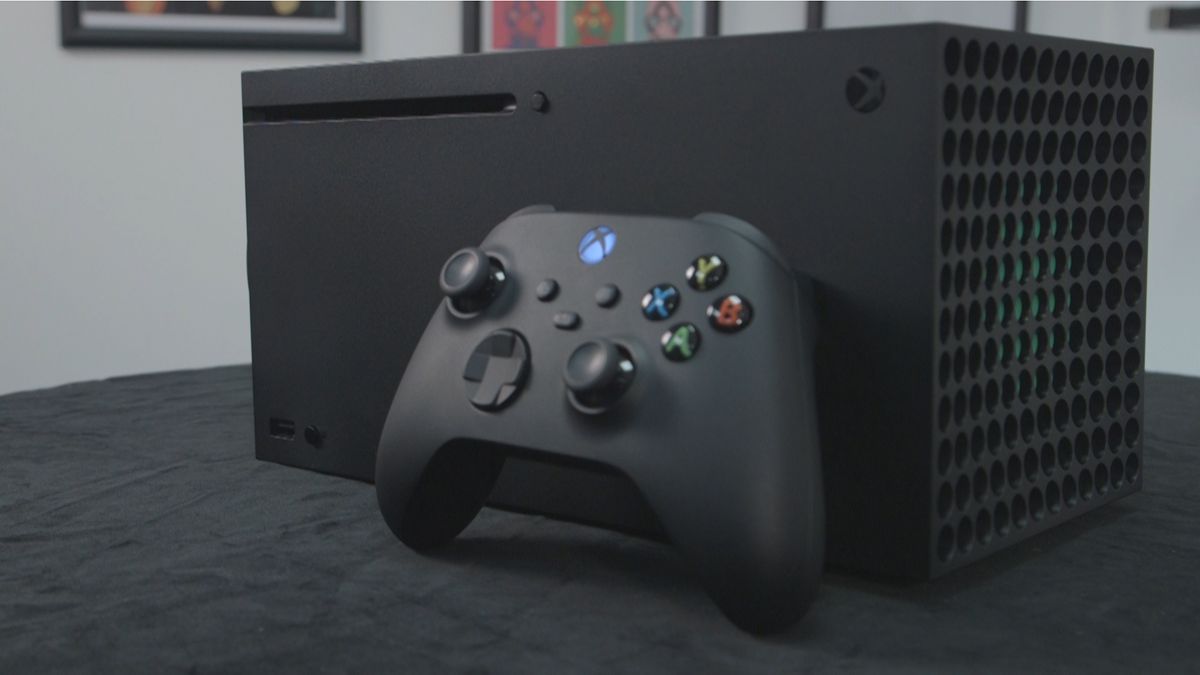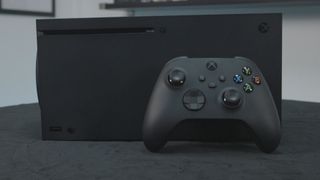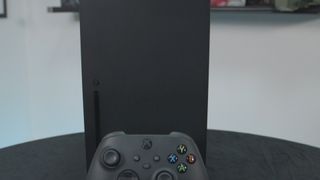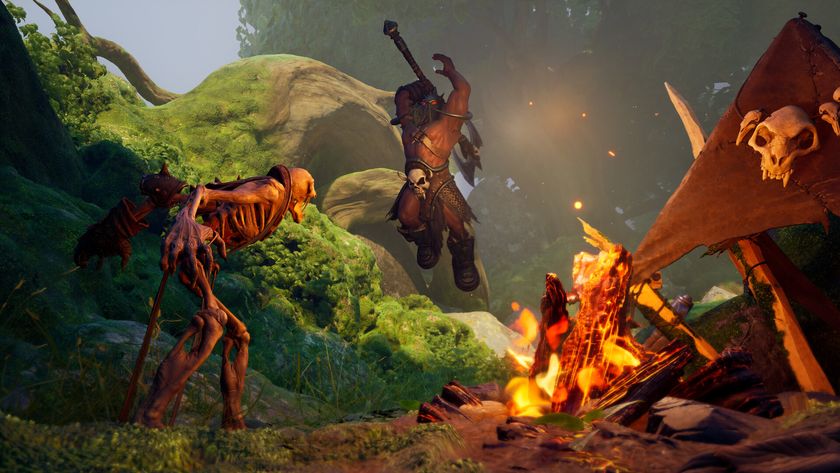
The Xbox Series X looks better in person than it does in pictures. I've had the pre-launch console set up in my lounge for the better part of a week now and my appreciation for its industrial design has only grown over that time. When Microsoft first unveiled the Xbox Series X design back in December of 2019, the monolithic slab of plastic cut an imposing figure. Sure, it exuded a domineering sense of power and confidence, but that isn't necessarily the vibe my small living room is trying to set.
And so the question of whether I'd want something as large as the Xbox Series X positioned beneath my television for the next decade had been something of an unanswerable question. As it should happen, the answer has been to not position it beneath anything. Only a monster would place the Xbox Series X horizontally in their home.
Xbox Series X design impressions
This is the first Xbox console that looks decidedly better when positioned in a vertical orientation. Perhaps that's because it's specifically designed to tower over your other devices. The Xbox logo adorning the power button in the top left corner sits askew if the system isn't standing, and the plastic stand affixed to the bottom of the console cannot be removed. One side does come equipped with small rubber feet should you decide to lay it down, but the console quickly begins to resemble the sort of unassuming black vault you'd expect to find concealing treasures in a vapid looter-shooter.
Another way Microsoft is encouraging you to keep the Xbox Series X vertically arranged is with respect to the venting array adorning the top of the console. The underside of the venting holes have been painted with a muted green, something that is unnoticeable at a distance but appears to radiate and pulse the closer you move towards the console. It's a nice touch, one that helps to bring a little flair to the curvature at the north-end of the system – a necessity, given the complicated cooling solution Microsoft has been forced to employ to keep this powerhouse running cool and quiet.

"I can say with some confidence that the Xbox Series X is the quietest Xbox console I've ever experienced"
I've been in the Xbox ecosystem for quite some time now. Over the last 18 years, I've been lucky enough to have either owned (or been in close proximity to) just about every major iteration of Xbox hardware. I'm telling you this only so that I can say the following with some confidence: the Xbox Series X is the quietest Xbox console I've ever experienced. That's caveated with the understanding that I'm yet to play any Optimised for Xbox Series X games, which I'm anticipating will be made available in the coming weeks and likely push the system more heavily than a standard backwards compatible title. Otherwise, the console stayed surprisingly silent through multi-hour sessions of Yakuza 0 and Red Dead Redemption 2, and in some (regretfully) long evenings with Call of Duty: Warzone over the weekend. The only time the Xbox Series X made a noticeable sound was during the installation of Titanfall 2 from disk, as the 4K UHD Blu-Ray Optical Drive whirred into life in service of backwards compatibility – physical media, who needs it?
Given the tech Microsoft has pushed into this sleek black box – AMD's Zen 2 CPU, the RDNA 2 GPU outputting 12 TFLOPs, a custom 1TB NVME SSD, among other components that I won't bore you with by listing – I'm impressed to see it run so quietly and quickly. We'll get into the performance of the Xbox Series X and the new Xbox Series X controller at a later date, as for now I want to stay focused on the design of the console itself. If there's anything to criticize the Xbox Series X design for so far, it'll be the matte-black finish. It's extremely sensitive to embellishments, even if handled with the care and attention that a $499/£450 piece of technology deserves. I've barely touched the thing since opening it up and it's already picked up a few scuff marks and scratches, and let's not even talk about the fingerprint impressions that covered the thing.
Quiet, confident, and powerful

While I could sit here and lament the lack of HDMI-IN (sparsely used on my Xbox One X, but used all the same) and the removal of the S/PDIF optical audio out port (R.I.P. my soundbar), I'm genuinely surprised by just how quickly I've become accustomed to the towering structure that is the Xbox Series X. It is a weighty, premium device that reflects the power within and the subsequent pricing required to to get it into your home.
Sign up to the GamesRadar+ Newsletter
Weekly digests, tales from the communities you love, and more
If you look back over the years, the Xbox consoles have always looked a little boisterous at launch and have settled down through subsequent revision. The original Xbox looked like a powerful toy, coming equipped with a controller too few could ever reasonably wrap their hands around. The Xbox 360 was a monstrous behemoth, with the eventual slim variant slotting more comfortably into the living room. The Xbox One looked like a bulky set-top box from a bygone era, although Microsoft's half-generation refresh in the Xbox One X was far less imposing... if not a little uninspired. What of the Xbox Series X then?
The Xbox Series X is big. It's a freaking monster compared to the Xbox Series S – there's no denying that – but it's also attractive in its own little way. It has a form-factor that I've quickly grown to appreciate, one that I suspect is concealing the power to change the way we play in the years to come.

In the coming weeks, GamesRadar+ will be exploring the Xbox Series X in detail. Our first impressions of the Xbox Series X design is just the beginning, so be sure to check back daily for more.

Josh West is the Editor-in-Chief of GamesRadar+. He has over 15 years experience in online and print journalism, and holds a BA (Hons) in Journalism and Feature Writing. Prior to starting his current position, Josh has served as GR+'s Features Editor and Deputy Editor of games™ magazine, and has freelanced for numerous publications including 3D Artist, Edge magazine, iCreate, Metal Hammer, Play, Retro Gamer, and SFX. Additionally, he has appeared on the BBC and ITV to provide expert comment, written for Scholastic books, edited a book for Hachette, and worked as the Assistant Producer of the Future Games Show. In his spare time, Josh likes to play bass guitar and video games. Years ago, he was in a few movies and TV shows that you've definitely seen but will never be able to spot him in.
Most Popular







